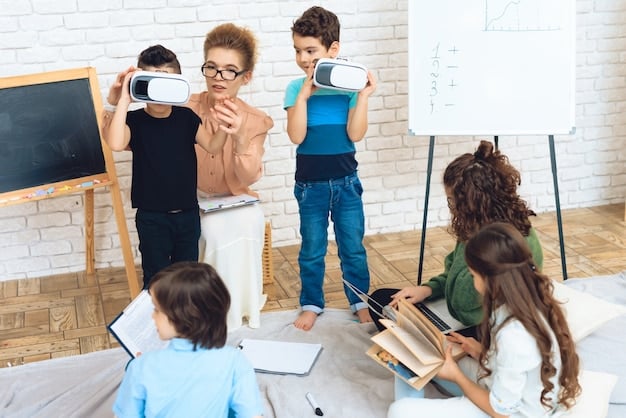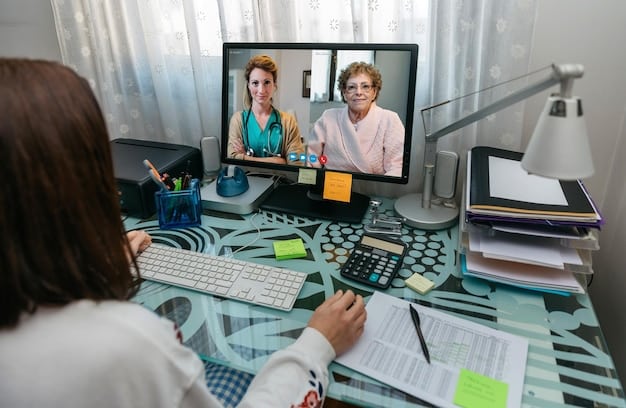The Future of Teacher Training: Preparing US Educators

The future of teacher training is evolving to equip US educators with the necessary skills and knowledge to effectively teach the next generation of learners, focusing on innovative techniques, technology integration, and personalized learning approaches.
The landscape of education is rapidly changing, requiring a fundamental shift in how teachers are trained and prepared. The future of teacher training: Preparing US educators for the next generation of learners involves incorporating new technologies, addressing diverse learning needs, and fostering innovative teaching methods.
Evolving Needs in Education
The demands placed on teachers are greater than ever. They are tasked with not only imparting knowledge but also fostering critical thinking, creativity, and social-emotional learning. Understanding these evolving needs is critical to shaping effective teacher training programs.
Teacher training must adapt to meet the challenges and opportunities presented by the 21st-century classroom. This includes preparing educators to work with increasingly diverse student populations and to effectively use technology to enhance learning.
Addressing Diversity and Inclusion
One key aspect of the evolving needs in education is the increasing diversity of student populations. Teachers must be prepared to create inclusive classrooms that meet the needs of all learners, regardless of their background or abilities.
Culturally responsive teaching is becoming increasingly important. This approach recognizes the importance of incorporating students’ cultural references into all aspects of learning.
Integrating Technology Effectively
Technology has the potential to revolutionize education, but only if it is used effectively. Teacher training programs must equip educators with the skills and knowledge to integrate technology into their teaching in meaningful ways.
This includes not only learning how to use specific software or apps but also understanding how technology can be used to enhance student engagement and personalize learning.

- Understanding diverse learning styles and needs
- Implementing inclusive classroom practices
- Using technology to personalize learning
- Creating a positive and supportive classroom environment
By focusing on these evolving needs, teacher training programs can better prepare educators to meet the challenges of the 21st-century classroom and to help all students succeed.
Innovative Training Methodologies
Traditional lecture-based approaches to teacher training are no longer sufficient. Innovative training methodologies, such as simulations, micro-teaching, and peer coaching, can provide more engaging and effective learning experiences.
These methods allow teachers to practice their skills in a safe and supportive environment and to receive feedback from peers and mentors.
Simulations and Virtual Reality
Simulations and virtual reality (VR) are increasingly being used in teacher training programs to provide realistic and immersive learning experiences. These technologies allow teachers to practice their skills in a variety of scenarios, such as managing classroom behavior or leading a difficult conversation with a parent.
VR simulations can also be used to create virtual classroom environments that reflect the diversity of student populations, allowing teachers to practice inclusive teaching strategies in a safe and controlled setting.
Micro-Teaching and Reflection
Micro-teaching involves teachers delivering short lessons to a small group of students or peers, which are then video-recorded and analyzed. This allows teachers to reflect on their teaching practices and identify areas for improvement.
Reflection is a key component of effective teacher training. By reflecting on their experiences, teachers can gain a deeper understanding of their own teaching practices and develop strategies for continuous improvement.
- Using simulations to practice classroom management
- Implementing micro-teaching for focused skill development
- Encouraging reflective practice for continuous improvement
- Leveraging peer coaching for collaborative learning
These innovative training methodologies can provide teachers with the skills and knowledge they need to be successful in the classroom.
The Role of Technology in Teacher Development
Technology plays a crucial role in modern teacher development, offering tools and platforms for professional learning, collaboration, and resource sharing. Integrating technology effectively into teacher training can significantly enhance the learning experience.
From online courses to digital collaboration tools, technology provides teachers with access to a wealth of resources and opportunities for professional growth.
Online Learning Platforms
Online learning platforms provide teachers with access to a wide range of courses and resources that can help them develop their skills and knowledge. These platforms often offer personalized learning experiences, allowing teachers to focus on areas where they need the most support.
Many online courses are designed to be self-paced, allowing teachers to learn at their own convenience. This flexibility is particularly valuable for teachers who have busy schedules.
Digital Collaboration Tools
Digital collaboration tools, such as online forums and social media groups, can help teachers connect with colleagues and share ideas and resources. These tools can also be used to create online communities of practice, where teachers can learn from one another and support each other’s professional growth.
Collaborative platforms facilitate peer observation and feedback, enabling teachers to learn from each other’s experiences and improve their teaching practices.

- Utilizing online learning platforms for professional development
- Employing digital collaboration tools for peer support
- Integrating technology into lesson planning and delivery
- Leveraging data analytics to personalize learning
By embracing technology, teacher training programs can create more engaging, effective, and personalized learning experiences for educators.
Personalized Learning Approaches for Teachers
Just as students benefit from personalized learning, so too can teachers. Personalized learning approaches recognize that teachers have different needs and learning styles, and they provide opportunities for teachers to customize their professional development experiences.
This includes tailoring training programs to meet individual needs, providing opportunities for teachers to choose their own learning pathways, and offering ongoing support and coaching.
Competency-Based Education
Competency-based education (CBE) is an approach to learning that focuses on the development of specific skills and knowledge. In CBE programs, teachers progress through the curriculum at their own pace, demonstrating mastery of each competency before moving on to the next.
CBE allows teachers to focus on the areas where they need the most support and to avoid spending time on topics they already know well.
Personalized Coaching and Mentoring
Personalized coaching and mentoring can provide teachers with individualized support and guidance. Coaches and mentors can help teachers identify their strengths and weaknesses, set goals, and develop strategies for improvement.
Mentoring programs provide new teachers with the support they need to succeed in their first years of teaching, while coaching programs can help experienced teachers refine their skills and knowledge.
- Implementing competency-based education for teachers
- Providing personalized coaching and mentoring
- Offering flexible learning pathways
- Utilizing data to track progress and personalize support
By adopting personalized learning approaches, teacher training programs can better meet the needs of individual teachers and promote their professional growth.
Addressing Teacher Well-being and Retention
Teacher well-being is essential for creating a positive and supportive learning environment for students. Teacher training programs must address the importance of self-care and provide teachers with the skills and resources they need to manage stress and prevent burnout.
Focusing on well-being can improve teacher retention rates, ensuring experienced educators remain in the profession.
Strategies for Managing Stress
Teaching can be a stressful profession, and teachers need to develop strategies for managing stress and preventing burnout. This includes learning how to set boundaries, prioritize tasks, and practice self-care.
Mindfulness and meditation techniques can also be helpful for managing stress and improving overall well-being.
Creating a Supportive Work Environment
Schools and districts can play a role in promoting teacher well-being by creating a supportive work environment. This includes providing teachers with opportunities for collaboration, professional development, and leadership.
Supportive school cultures encourage open communication, provide resources for mental health, and acknowledge teachers’ contributions.
- Teaching stress management techniques
- Promoting self-care and mindfulness
- Creating supportive school environments
- Offering resources for mental health and well-being
By prioritizing teacher well-being, schools and districts can create a more positive and sustainable environment for both teachers and students.
Policy and Investment in Teacher Training
Effective teacher training requires a commitment from policymakers and significant financial investment. Policies that support high-quality teacher preparation programs and ongoing professional development are essential for ensuring that all students have access to effective teachers.
Investment in teacher training also leads to better student outcomes and a more skilled workforce.
Government Initiatives and Funding
Government initiatives and funding can play a critical role in supporting teacher training programs. This includes providing scholarships and loan forgiveness programs for aspiring teachers, as well as funding for professional development opportunities.
Investing in evidence-based teacher training programs can lead to significant improvements in student achievement.
Partnerships Between Universities and Schools
Partnerships between universities and schools can create valuable opportunities for teacher training. These partnerships allow teacher candidates to gain practical experience in real-world classroom settings, while also providing schools with access to the latest research and best practices.
Collaborative efforts between universities and schools ensure that teacher training is relevant and responsive to the needs of the classroom.
- Advocating for government funding for teacher training
- Supporting partnerships between universities and schools
- Implementing policies that prioritize high-quality teacher preparation
- Encouraging continuous professional development for teachers
By prioritizing policy and investment in teacher training, we can ensure that all students have access to effective and well-prepared teachers, leading to better educational outcomes for all.
| Key Point | Brief Description |
|---|---|
| 🚀 Evolving Needs | Education demands adaptable training for diverse, tech-integrated learning. |
| 💡 Innovative Methods | Simulations, micro-teaching, and peer coaching for hands-on experience. |
| 💻 Tech Integration | Technology facilitates learning, collaboration, and personalized development. |
| 🌱 Well-being Focus | Prioritizing teacher well-being improves retention and learning environments. |
Frequently Asked Questions
▼
Future teacher training emphasizes technology integration, personalized learning, inclusive practices, and a focus on teacher well-being to equip educators for diverse classrooms.
▼
Technology offers online learning platforms, digital collaboration tools, and data analytics to personalize learning, allowing teachers to develop skills efficiently.
▼
Personalized learning addresses individual needs and learning styles, providing tailored training, flexible pathways, and support to improve teacher effectiveness.
▼
Teacher well-being is crucial; stress management and supportive environments improve teacher retention and create positive, effective learning atmospheres for students.
▼
Policy changes should prioritize funding for high-quality programs, foster university-school partnerships, and support continuous professional development to ensure effective teacher preparation.
Conclusion
The future of teacher training in the US hinges on embracing innovative methodologies, leveraging technology, and prioritizing teacher well-being. By adapting to meet the evolving needs of students and educators, we can ensure a brighter future for education.





